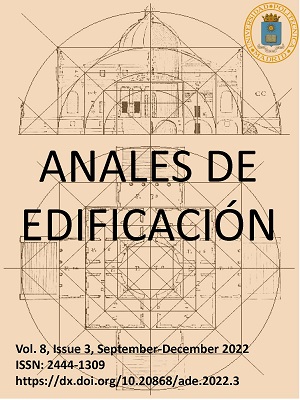Aplicación de una herramienta avanzada de análisis de datos en el entorno de la construcción = Application of advanced data analysis tool in building environment.
DOI:
https://doi.org/10.20868/ade.2022.5090Palabras clave:
Detección y diagnóstico de fallos, Instalaciones térmicas, Aprendizaje automático, SCADA, Software R, Fault detection and diagnosis, Thermal facilities, Machine learning, R softwareResumen
Los sistemas de monitorización de edificios proporcionan grandes volúmenes de información y existen herramientas avanzadas de análisis de datos. Un problema de detección y diagnóstico de fallos (FDD) en los sistemas energéticos de los edificios también puede considerarse un problema de aprendizaje automático puro. El objetivo de este trabajo es promover la FDD con aplicaciones de aprendizaje automático en el entorno de los edificios. Como contribución, en este trabajo se procesan series de datos temporales brutos, obtenidos de un SCADA, para la posterior construcción de patrones de una instalación térmica de un edificio. La instalación térmica abastece las demandas de ACS y calefacción de un edificio residencial, compuesto por 26 viviendas sociales y situado en Durango (norte de España). Los datos registrados cada 24 horas en valores acumulados se incluyen en el software R para el cálculo de gráficos estadísticos. Para los valores de los contadores de consumo de ACS y calefacción se obtienen 229 puntos de datos válidos y los rangos de consumo diario están comprendidos entre 1,94 - 5,90 m3 y 0 - 547,63 kWh.
Abstract
Building monitoring systems deliver large volumes of information and advanced data analysis tools are available. A fault detection and diagnosis (FDD) problem in building energy systems can also be regarded as a pure machine learning problem. The aim of this work is to promote FDD with machine learning applications in building environment. As a contribution, in this work raw time data series, obtained from a SCADA, are processed for further pattern construction of a building thermal facility. The thermal facility supplies the DHW, and heating demands of a residential building, consisting of 26 social dwelling units and located at Durango (northern Spain). Data recorded every 24 hours in cumulative values is included in the R software for computing statistical graphs. For DHW and heating consumption meter values, 229 valid data points are obtained, and the daily consumption ranges are between 1.94 - 5.90 m3 and 0 - 547.63 kWh respectively.
Descargas
Referencias
A.Afram and F. Janabi-Sharifi, ‘Black-box modeling ofresidential HVAC system and comparison of gray-box andblack-box modeling methods’, Energy Build., vol. 94, pp.121–149, 2015, doi: 10.1016/j.enbuild.2015.02.045.
M.W. Ahmad, M. Mourshed, B. Yuce, and Y. Rezgui,‘Computational intelligence techniques for HVAC systems:A review’, Build. Simul., vol. 9, no. 4, Art. no. 4, 2016, doi:10.1007/s12273-016-0285-4.
ASHRAE, ‘ASHRAE Guideline 14–2014, Measurement of Energy and Demand Savings’. 2014.
BEST, Bilbao Energy Solutions Trends, ‘Heating installation and centralized DHW production in a building of 26 social housing units in Durango. Execution project.’ 2012.
Boyer, S. A., ‘SCADA: supervisory control and data acquisition. International Society of Automation’. 2009.
European Union, Consolidated version of the Treaty on the Functioning of the European Union. PART THREE - UNION POLICIES AND INTERNAL ACTIONS TITLE XX - ENVIRONMENT Article 191 (ex Article 174 TEC). 2016.[Online]. Available:http://data.europa.eu/eli/treaty/tfeu_2016/art_191/oj
S. A. Kalogirou, ‘Artificial intelligence for the modeling and control of combustion processes: A review’, Prog. Energy Combust. Sci., vol. 29, no. 6, pp. 515–566, 2003, doi: 10.1016/S0360-1285(03)00058-3.
S.Katipamula and M. R. Brambley, ‘Review article: Methodsfor fault detection, diagnostics, and prognostics for buildingsystems—A review, part I’, HVAC R Res., vol. 11, no. 1,pp. 3–25, 2005, doi: 10.1080/10789669.2005.10391123.
W.Kim and S. Katipamula, ‘A review of fault detection anddiagnostics methods for building systems’, Sci. Technol.Built Environ., vol. 24, no. 1, pp. 3–21, 2018, doi:10.1080/23744731.2017.1318008.
A.Kylili, P. A. Fokaides, and P. A. L. Jimenez, ‘KeyPerformance Indicators (KPIs) approach in buildingsrenovation for the sustainability of the built environment: Areview’, Renew. Sustain. Energy Rev., vol. 56, pp. 906–915, 2016, doi: https://doi.org/10.1016/j.rser.2015.11.096.
M.Lumbreras, R. Garay, and A. G. Marijuan, ‘Energy metersin district-heating substations for heat consumptioncharacterization and prediction using machine-learningtechniques’, in IOP Conference Series: Earth andEnvironmental Science, 2020, vol. 588, no. 3. doi:10.1088/1755-1315/588/3/032007.
M.S. Mirnaghi and F. Haghighat, ‘Fault detection anddiagnosis of large-scale HVAC systems in buildings usingdata-driven methods: A comprehensive review’, EnergyBuild., vol. 229, 2020, doi: 10.1016/j.enbuild.2020.110492.
R software. 2022. [Online]. Available: https://www.r-project.org/
The Spanish Government´s Institute for Diversification and Saving of Energy (IDAE), ‘Studies, reports, and statistics’, 2018. http://sieeweb.idae.es/consumofinal/bal.asp?txt=2018&tipbal=t
H.Yang, T. Zhang, H. Li, D. Woradechjumroen, and X. Liu,‘HVAC Equipment, Unitary: Fault Detection andDiagnosis’, Encyclopedia of Energy Engineering andTechnology. Taylor & Francis, Ed. CRC Press, pp. 854–864, 2014.
R.Yang and G. Rizzoni, ‘Comparison of model-based vs. data-driven methods for fault detection and isolation in engineidle speed control system’, in Proceedings of the AnnualConference of the Prognostics and Health ManagementSociety, PHM, 2016, vol. 2016-October, pp. 25–33.
Descargas
Publicado
Número
Sección
Licencia
Derechos de autor 2023 Autor / BY-NC

Esta obra está bajo una licencia internacional Creative Commons Atribución-NoComercial-SinDerivadas 4.0.
1. Los autores conservan los derechos de autor y garantizan a la revista el derecho de una Licencia Creative Commons Atribución - Nocomercial 4.0 Internacional que permite a otros compartir el trabajo con un reconocimiento de la autoría y uso no comercial.
2. Los autores pueden establecer por separado acuerdos adicionales para la distribución no exclusiva de la versión de la obra publicada en la revista (por ejemplo, situarlo en un repositorio institucional o publicarlo en un libro).
Salvo indicación contraria, todos los contenidos de la edición electrónica se distribuyen bajo una licencia de uso y distribución “Creative Commons"












